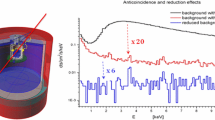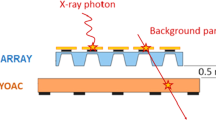Abstract
The TES cryogenic detectors, due to their high spectral resolution and imaging capability in the soft X-ray domain, are the reference devices for the next proposed space missions whose aims are to characterize the spectra of faint or diffuse sources. ATHENA is the re-scoped IXO mission, and one of its focal plane instrument is the X-ray Microcalorimeter Spectrometer (XMS) working in the energy range 0.3–10 keV. XMS will be able to achieve the proposed scientific goals if a background lower than 0.02 cts/cm2/s/keV is guaranteed. The studies performed by GEANT4 simulations depict a scenario where it is mandatory to use an active Anti-Coincidence (AC) to reduce the expected background in the L2 orbit down to the required level. This is possible using a cryogenic AC detector able to provide a rejection efficiency of about 99%. We are developing for this purpose a TES-based detector made by Silicon absorbers (total assembled area about 1 cm2 and 300 μm thick) and sensed by a Ir:Au TES. All the work done for IXO is applicable to ATHENA, with more margins due to the smaller area required for the detector. Here we present the results obtained from different samples, as a step towards the final detector design.














Similar content being viewed by others
References
C.K. Stahle et al., Proc. SPIE 3765, 128 (1999)
C. Macculi et al., Proc. SPIE 7732, 773 (2010)
F. Pröbst et al., J. Low Temp. Phys. 100, 69 (1995)
S.H. Moseley, J.C. Mather, J. Appl. Phys. 56, 1257 (1984)
M. Chapellier, Nucl. Instrum. Methods Phys. Res. A 520, 21 (2004)
L. Piro et al., Report on the cryo-Anticoincidence detector for IXO-XMS, TN_ACD_10_1, Report to ESA for the IXO Technical Review (2010)
C. Macculi et al., in preparation
D. Cea, S. Lombardo, A. Ritacco, The astrophysics and the TES. Tech report of Astrophys. LAB for Degree in Phys., Univ. La Sapienza, Roma (2011)
M.R. Hauser et al., Phys. Rev. B 60, 3072 (1999)
M.E. Msall, J.P. Wolfe, Phys. Rev. B 65, 195205 (2002)
Acknowledgements
The authors acknowledge ASI under contract I/035/10/0, and the INAF/IASF Roma institute for its support.
Author information
Authors and Affiliations
Corresponding author
Rights and permissions
About this article
Cite this article
Macculi, C., Colasanti, L., Lotti, S. et al. The Cryogenic Anticoincidence Detector for ATHENA-XMS. J Low Temp Phys 167, 783–794 (2012). https://doi.org/10.1007/s10909-012-0504-z
Received:
Accepted:
Published:
Issue Date:
DOI: https://doi.org/10.1007/s10909-012-0504-z




